What is it
If you have been sailing on-board ships, then you must have certainly worked on Gyro-compass.
This helps the ship in direction finding. Actually it shows the ship, in which direction it is heading.
Gyro-compass is basically a gyroscope, with three degrees of freedom.
So if you don’t know how a gyroscope helps in direction finding. Lets take a tour about how does it work.
Table of contents
- Gyroscope
- Gyroscope usage
- Three degrees of freedom
- Properties of gyroscope
- Direction finding
- Working of Gyro-compass
- Top heavy/ Bottom heavy gyro
- Making gyro north seeking
- Damping of gyro compass
- Errors in Gyro-compass
- Regulations regarding gyro-compass
Gyroscope
Gyroscope is basically a wheel or Rotor, which is framed around the axis. This axis is called Spin axis.
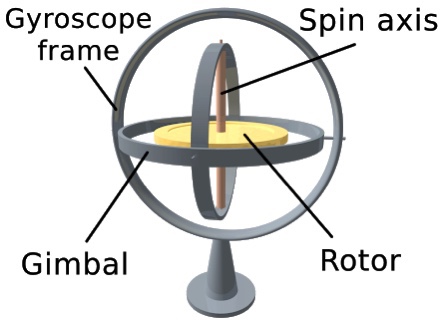
You can see the spin axis in above picture. So the wheel is rotating around the spin axis continuously at high RPM.
Gyroscope usage
Whether is is mobile or on a vessel. Gyroscope is used for the direction finding purpose. Which means it measures angle and then judges it’s own orientation precisely. Then it applies the correction accordingly in the device to attain the desired angle or direction.
Three degrees of freedom
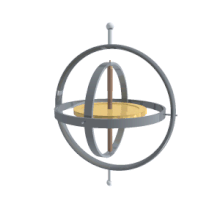
The first movement is called Spinning freedom. Where the wheel in the gyroscope, is spinning around its spin axis.
Then there is tilting freedom, about a horizontal axis at right angles to the spin axis.
The third degree of freedom is veering freedom, about a vertical axis perpendicular to both the other axes.
The rotor is mounted on two concentrically pivoted rings, called inner and outer rings. This assembly is called the gimbal system.
Here is the video to help understand this better.
Also read: Ranakpur temple- The most captivating Jain temple
Properties of Gyroscope
Following are two properties of Gyroscope which helps gyro in finding the direction and maintaining its position in space.
Gyroscopic Inertia
It is the property of a gyroscope, which causes it to maintain its position in space, irrespective of any movement.
And because of this property, the gyroscope resists any force tending to turn its spin axis in new direction.
So let’s say for example, that we turn the rotor at a high RPM around the spin axis. Once the rotor starts spinning, the spin axis starts pointing in one direction.
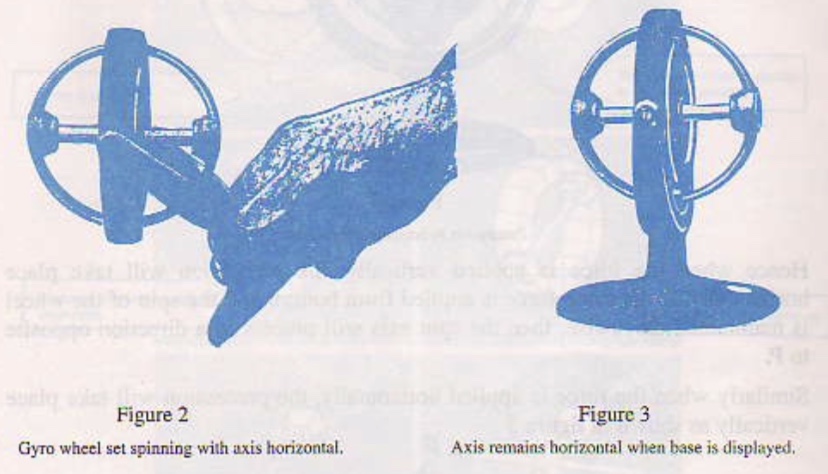
Once the spin axis attains one direction, after that no matter how we turn the supporting base. The direction of the spin axis will not change.
This property will be useful for Gyroscope to maintain position in one direction.
Precession
When we apply torque to the spin axis of gyroscope. Then the angular displacement of spin axis is called precession.
So when a torque is applied then the resultant movement will be in a direction right angle to the applied torque.
The above phenomenon happens because when we apply torque, then it reacts not only on the spin axis, but also on the rotor(wheel) which is rotating at a high RPM.
So as soon we apply some torque(force) to the spin axis, it moves in the direction resultant to the applied Torque and the spinning wheel.
Precession depends upon the following factors:
- Direction of spin of the wheel
- point of applied force
- Direction in which the force is applied
This is the second property of gyro-compass which is very useful to make the gyro north-seeking.
So how does it show Direction
Since we know about both the properties of a gyroscope. Now we will go to the next step about how these properties help gyro in direction finding.
As we all know that there are Four cardinal directions. They are East, West, North and South.
And there are two geographic poles on earth. The poles are named North Pole and South Pole.
North direction shows the True North pole of the earth. Which is also called True Geographic North.
While South direction shows the true South Pole of the earth. Which is also called True Geographic South.
The gyro-compass is used to provide directional reference with respect to True geographic North.
The function of gyro-compass is to show the True North direction or any of the other direction with respect to North.
Compass card is divided into 360 degrees. Where 000 degrees shows the True North, 090 shows East and so on.
So the needle in the Gyro-compass card points to the direction which is shown as relative to the True north direction.
Working of a Gyro-compass
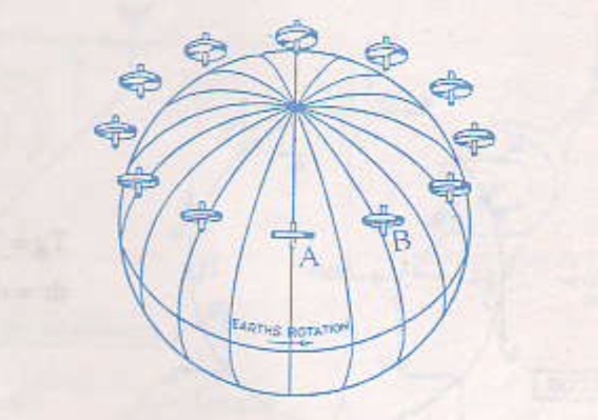
Let’s try to understand the movement of spin axis on the surface of the earth.
Suppose the gyroscope is placed at point A, as per above diagram. As we can see, that when gyroscope is at point A, it is pointing towards True geographic North.
Now when the earth has revolved a little and gyroscope reaches point B. At this point the spin axis is not pointing to the true geographic north. But it is still pointing at the same direction with respect to the space.
Now if we imagine an imaginary star(called gyro star) in the celestial sphere where the spin axis of the gyroscope is pointing. Then the spin axis will keep on pointing in the same direction towards the gyro star.
So we can see that the gyro star will also rise, culminate and set with the rotation of the earth.
Now, suppose the earth is stationary, then the gyroscope will keep pointing in one direction all the time. And there will be no issue in finding the direction.
But because of the rotation of the earth, the Coriolis force of the earth is acting upon the gyroscope and it can not get steady in one direction.
To maintain the same direction of the spin axis in space. The spin axis has to move with respect to the earth’s surface.
This movement of the spin axis is changing in altitude and azimuth. This movement is called tilt and drift respectively.
Tilt: The movement of spin axis about the horizontal is called tilt.
Tilting= 15 sin(Azimuth) X cos (latitude)
Drift: The movement of the spin axis in the direction of azimuth is called drift.
Drifting= 15 sin(latitude)
This movement of Gyroscope because of the rotation of the earth is called the free gyroscope.
Gravity controlled Gyro (Top heavy and Bottom heavy effect)
The spin axis of the free gyroscope is moving but it can not assist us in direction finding. In order to make it stable in one direction, we have to control its spin axis.
To control the movement of spin axis, we use the property of gyro called Precession.
As we know that once we apply torque to the spin axis, it precess in the perpendicular direction of the torque.
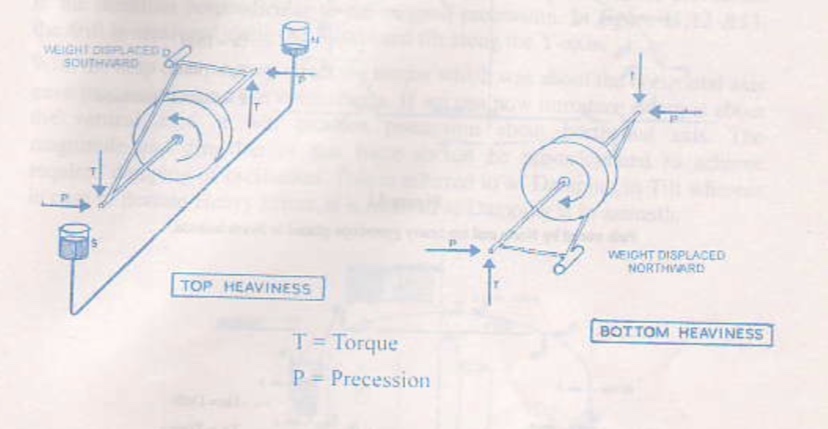
As we can see in the above diagram, The wheel is spinning in anti-clockwise direction in the left diagram.
When the earth rotates, the North end of the spin axis will tilt upwards. So we place the mercury ballistic or top heavy weight on the spin axis.
As the spin axis tilts upwards, the mercury flows from N to S direction due to gravity and it provides the torque required. And because of the torque, the spin axis precess towards west.
On the other hand, spin axis is spinning clockwise in the right hand side diagram. And we want the spin axis to precess westwards as per above diagram.
Then we place the weigh at bottom of the spin axis, which is called Bottom heavy effect. Due to this effect, again the spin axis precess towards west.
How to make gyro North seeking
As we have seen that, by adding top heavy or bottom heavy effect we have made the gyro point towards the meridian.
But due to the torque and precession, it keeps on oscillating around the meridian. It won’t point in one direction.
While the requirement of the gyro is that it must settle down and maintain a fixed direction with respect to the earth.
The settling of the gyro should be such that even if it is disturbed, it should return back to it’s direction.
In order to make it North seeking, we have to reduce its oscillations. So the oscillations can be reduced by damping the gyro.
To damp the gyroscope, we have to apply another torque perpendicular to the first torque. This torque will cause precession in the direction perpendicular to the original precession.
Damping the Gyro-compass
When the gyro with the top heavy effect is damped, it is called as Damping in tilt.
Whereas damping the bottom heavy gyro is called Damping in azimuth.
As we know that in the top heavy effect, the weight was connected at he centre line of the wheel/rotor.
So damping in tilt is done by shifting the same weight slightly east of the vertical passing through centre of gravity of wheel/rotor.
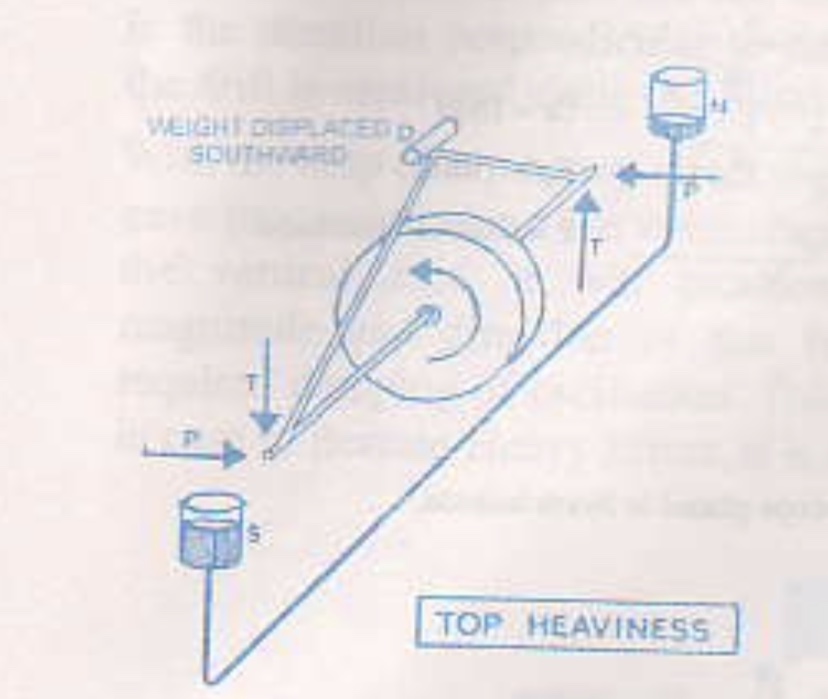
As we have seen in top heavy effect, that torque was applied in horizontal axis. And the precession was about the vertical axis.
while in damping, the same force produces a torque about the vertical axis. And it results in precession about the horizontal axis.
Which causes the amplitude of oscillations to reduce. And finally the gyro settles down in the meridian.
Errors in Gyro-compass
These are a few errors in gyro, which can cause it to give wrong readings.
Speed error
if the ship is stationary, then the gyro will settle down in the meridian as explained above.
But as soon the ship starts moving, the course and speed affect the reading in gyroscope.
As the earth rotates from west to east, the error is nil on east-west courses. While it is maximum on North-South course.
This error increases with speed and latitude.
Damping or Latitude error
In case of damping in tilt, the spin axis will settle a little east or west of meridian. This error increases with latitude.
This error is calculated and applied as latitude correction. Gyros which are damped in azimuth are not subjected to this error.
The speed and latitude correction are corrected automatically by latitude rider and speed rider fixed to the gyro.
These speed and latitude rider have feed from speed log and gps. So the corrections are applied automatically or manually depending on the equipment.
Regulations regarding Gyro-compass
Following are a few regulations which should be followed in the maritime industry.
- All ships over 500GRT should have a gyro compass installed on-board
- It must point to True geographic north.
- Must be able to transmit data to all instruments requiring this information
- It can not be replaced by magnetic compass
- Must be able to take bearings over 360 degree around the ship
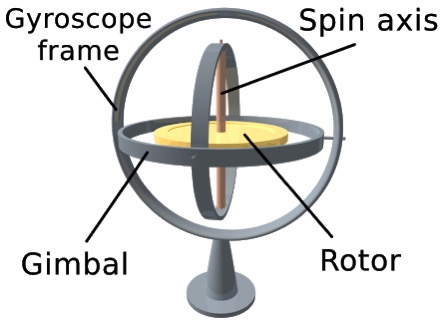


Interesting, but difficult for a lay person to understand. Will have to reread several times!